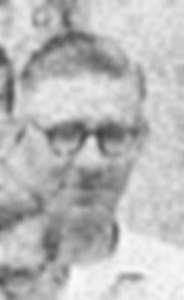Difference between revisions of "D.W.G. Arthur"
(Created page with "<div id="content_view" class="wiki" style="display: block"> =David "Dai" Arthur= ''(lunar scientist)''<br /> <div id="toc"> =Table of Contents= <div style="margin-left: 1e...") |
|||
| (2 intermediate revisions by the same user not shown) | |||
| Line 2: | Line 2: | ||
=David "Dai" Arthur= | =David "Dai" Arthur= | ||
''(lunar scientist)''<br /> <div id="toc"> | ''(lunar scientist)''<br /> <div id="toc"> | ||
| − | + | ||
| − | |||
==Lunar Work== | ==Lunar Work== | ||
| − | A founding member of the University of Arizona's [ | + | A founding member of the University of Arizona's [[LPL|Lunar and Planetary Laboratory]], Arthur came to Tucson with [[Gerard%20Kuiper|Gerard Kuiper]] and [[Ewen%20Whitaker|Ewen Whitaker]] by way of Yerkes Observatory. At the [[LPL|LPL]] he oversaw work on the ''[[System%20of%20Lunar%20Craters|System of Lunar Craters]]'' (a major revision of the [[IAU%20nomenclature|IAU nomenclature]]) and the [[ULCN|Tucson Selenodetic Triangulation]] (a new system of positional control points on the Moon). He ended his career with the [[USGS|USGS]] in Flagstaff where he applied his experience primarily to the analysis of Viking photographs of Mars.<br /> <br /> |
==Where & When== | ==Where & When== | ||
| − | * Before joining Kuiper, Arthur enjoyed some repute as a member of the Lunar Section of the [ | + | * Before joining Kuiper, Arthur enjoyed some repute as a member of the Lunar Section of the [[BAA|BAA]]. His activities were highlighted as an example of the kinds of significant work that could be contributed by a dedicated amateur in a 1956 article by ''Sky and Telescope'' editor Joseph [[Ashbrook|Ashbrook]]. It seems that Arthur, then living in Workingham, England, had self-published four issues of what he called ''Contributions to Selenography'' mostly featuring measurements he made on copies of glass negatives obtained from Mount Wilson and Lick Observatories. Volume 1 was a list of 1,400 crater diameters measured by J. Young; Volume 2 gave precise positions for 490 features in [[Mare%20Imbrium|Mare Imbrium]]; Volume 3 added 300 features in [[Oceanus%20Procellarum|Oceanus Procellarum]]; Volume 4 gave formulas for converting the X-Y positions observed on a lunar plate to their positions at zero libration; and Volume 5 listed 580 points around [[Copernicus|Copernicus]]. Ashbrook predicted that these would become extremely rare in future years, since in some cases, less than 50 copies were distributed. <span class="membersnap">- Jim Mosher</span> |
| − | * '''Arthur''' was once the name for crater '''Anaximander C''' (H.P.Wilkins and P.Moore''',''' see their book ''THE MOON''). Indeed, certain maps of the moon's nearside show the name '''Arthur'''. See also [http://the-moon. | + | * '''Arthur''' was once the name for crater '''Anaximander C''' (H.P.Wilkins and P.Moore''',''' see their book ''THE MOON''). Indeed, certain maps of the moon's nearside show the name '''Arthur'''. See also [http://the-moon.us/wiki/Unofficial%20Names%20of%20Hugh%20Percy%20Wilkins Wilkins's and Moore's list of their nomenclature]. <span class="membersnap">- DannyCaes <small>Mar 30, 2018</small></span> |
<br /> | <br /> | ||
==Personal Information== | ==Personal Information== | ||
===Photo=== | ===Photo=== | ||
| − | [[Image:DWG_Arthur.jpg|DWG_Arthur.jpg]] from [ | + | [[Image:DWG_Arthur.jpg|DWG_Arthur.jpg]] from [[LPL|Whitaker, 1985]] p. 24 (see also p.26)<br /> <br /> |
===Birth=== | ===Birth=== | ||
Wales<br /> <br /> | Wales<br /> <br /> | ||
| Line 38: | Line 37: | ||
---- | ---- | ||
| − | + | </div> | |
Latest revision as of 16:19, 15 April 2018
Contents
David "Dai" Arthur
(lunar scientist)Lunar Work
A founding member of the University of Arizona's Lunar and Planetary Laboratory, Arthur came to Tucson with Gerard Kuiper and Ewen Whitaker by way of Yerkes Observatory. At the LPL he oversaw work on the System of Lunar Craters (a major revision of the IAU nomenclature) and the Tucson Selenodetic Triangulation (a new system of positional control points on the Moon). He ended his career with the USGS in Flagstaff where he applied his experience primarily to the analysis of Viking photographs of Mars.
Where & When
- Before joining Kuiper, Arthur enjoyed some repute as a member of the Lunar Section of the BAA. His activities were highlighted as an example of the kinds of significant work that could be contributed by a dedicated amateur in a 1956 article by Sky and Telescope editor Joseph Ashbrook. It seems that Arthur, then living in Workingham, England, had self-published four issues of what he called Contributions to Selenography mostly featuring measurements he made on copies of glass negatives obtained from Mount Wilson and Lick Observatories. Volume 1 was a list of 1,400 crater diameters measured by J. Young; Volume 2 gave precise positions for 490 features in Mare Imbrium; Volume 3 added 300 features in Oceanus Procellarum; Volume 4 gave formulas for converting the X-Y positions observed on a lunar plate to their positions at zero libration; and Volume 5 listed 580 points around Copernicus. Ashbrook predicted that these would become extremely rare in future years, since in some cases, less than 50 copies were distributed. - Jim Mosher
- Arthur was once the name for crater Anaximander C (H.P.Wilkins and P.Moore, see their book THE MOON). Indeed, certain maps of the moon's nearside show the name Arthur. See also Wilkins's and Moore's list of their nomenclature. - DannyCaes Mar 30, 2018
Personal Information
Photo
 from Whitaker, 1985 p. 24 (see also p.26)
from Whitaker, 1985 p. 24 (see also p.26)
Birth
Wales
Death
Deceased ?
Education
Current Contact Information/Websites
Publications
LPODs
Bibliography
- J. Ashbrook. (1956). "Surveying the Moon." Sky and Telescope (Aug. issue), p. 452.
- The appearance of the name Arthur near the north-northwestern part of the moon's limb, see Section 6 (chart) on page 256 of Patrick Moore's New Guide To The Moon (Norton, 1976).
- Would be interesting to see all of Patrick Moore's and Hugh Percy Wilkins's names on the nomenclature overlay of the LROC ACT-REACT QUICK MAP.